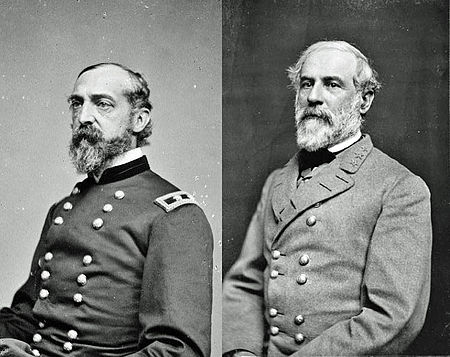
Left: US Gen. George Meade; Right: CS Gen. Robert E. Lee
Today we mark the 150th Anniversary of the first day of the Battle of Gettysburg, Pennsylvania, fought between the 75,000-man Confederate Army of Northern Virginia under the command of General Robert E. Lee and the 90,000-man Union Army of the Potomac under the command of Major General George G. Meade.

The route of the invasion and army movements leading up to Gettysburg. Attribution: Map by Hal Jespersen, www.posix.com/CW
In the wake of the defeat of the Union Army of the Potomac at the Battle of Chancellorsville, Robert E. Lee decided, once again, to take the war north of the Potomac River and invade the Union with his Confederate Army of Northern Virginia. In addition to allowing his army the opportunity for better forage away from the exhausted territory of Northern Virginia, he also sought to draw the Army of the Potomac into the open where he hoped to win a decisive victory. A crushing victory over the main Union field army on Union territory, and only a stone's throw from the US capital city, would, it was hoped, break the Northern resolve and win Southern independence.
Lee had two significant disadvantages against which he would have to contend during this battle: first, he had lost his right arm, CS Lt. General Thomas "Stonewall" Jackson -- and Jackson's Corps was now divided into two Corps, one under CS Gen. Richard Ewell, and the other under CS Gen. A.P. Hill. The other challenge was that he had lost contact with his cavalry under CS Gen. JEB Stuart. Stuart, still a bit embarrassed from being surprised at Brandy Station, now attempted to recover his reputation by riding around the Union army -- leaving Lee, however, without the scouting he would need to effectively conduct the campaign.
Map of the first day of the Battle of Gettysburg. Attribution: Map by Hal Jespersen, www.posix.com/CW
US General John Reynolds, commanding I Corps, and killed at Gettysburg, 1 July 1863.
On 1 July 1863, elements of A.P. Hill's Confederate Third Corps -- Henry' Heth's division -- marched into Gettysburg, PA, in search of shoes. Instead, they were met by Union Cavalry under US General Buford, and soon after that, infantry of the Union I Corps under US Gen. John Reynolds. By the end of the day, portions of both the Confederate Second Corps, of Ewell, and Third Corps, of Hill, had driven the I Corps, of Reynolds (killed in the action), and XI Corps, of Howard, back from Seminary Ridge to a position on Cemetery Ridge south of the town of Gettysburg. This XI Corps, that was driven back through the town of Gettysburg, was the same XI Corps on the flank of the Union army at Chancellorsville that was scattered by Jackson's flank attack there.
The first day of action, though not initially intended by the Confederates to bring on a major battle, had gone well for the Southern forces, and the next day would bring an escalation of the fight as the rest of the two armies arrived on the scene.
For more on the Battle of Gettysburg, you might note:
National Park Service Description
Official Website of Gettysburg National Military Park
Civil War Home: Gettysburg
Tomorrow, the fight moves to the flanks of the Union army and such iconic locations as Little Round Top, Devil's Den, the Wheatfield, the Peach Orchard, and Culp's Hill...
Live well!
No comments:
Post a Comment